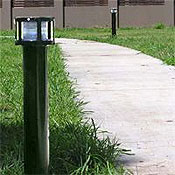Redland Shire Council used Orion Solar Solutions to implement two projects involving solar powered lighting to increase security of public walkways within it’s residential sub-divisions.
 |
| Orion’s bollards have virtually no maintenance and no running costs. |
Orion Solar Solutions had originally been appointed as a preferred supplier to the Council for supplying marine navigation lights for the Council’s waterways in Moreton Bay. As a result of this relationship, Council saw opportunities to illuminate pedestrian walkways using some of Orion’s other products.
Council installed a total of 10 of Orion’s self contained solar powered bollards to illuminate a pathway through a park. Each bollard contains a Carmanah 601 solar LED light which has been field proven in rugged marine and military environments. The units were installed in minutes, requiring no trenching for power cables and the lights switch on automatically at dusk and off at dawn. With virtually no maintenance and no running costs, Orion’s bollards are a fraction of the cost of traditional hard wired electrical bollards. Redland Shire is looking to enhance safety and reduce costs by using Orion Solar Bollards in other projects around the Shire.
In another project, a `Carmanah` GI-100 solar powered LED lighting system was installed to illuminate a public easement between a residential street and a shopping centre, previously frequented by local youths. The GI-100 includes a head unit with solar panel, batteries and electronics, interconnected to dual luminaires that can be mounted in a variety of positions. The GI-100 is frequently used to illuminate bus shelters, picnic sites and other outdoor facilities.
As with all of Orion’s solar lights, the GI-100s switch on and off automatically, require almost no maintenance, incur no running costs and are inexpensive to install. The lights are in use around the world, in many cases in latitudes where they receive only a few hours of sunlight each day.